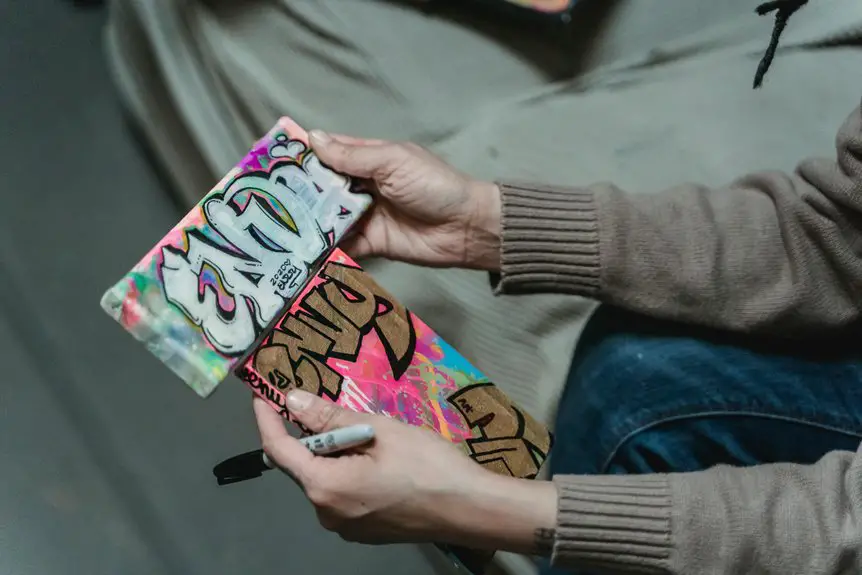To remove china marker from fabric, first identify your fabric type and test for colorfastness by blotting a hidden spot with water. Then, gently blot the stain with a mixture of mild detergent and warm water, avoiding rubbing. For tougher spots, try a vinegar and baking soda fizz or a commercial stain remover, always testing it on a hidden area. Handle stains carefully to prevent damage, and keep in mind there are more tips and solutions to explore for best results.
Table of Contents
Key Takeaways
- Identify the fabric type and test for colorfastness on a hidden spot before stain removal.
- Gently blot the china marker stain with a mild detergent solution and rinse with cold water.
- Use rubbing alcohol by dabbing the stain, letting it sit for 5 minutes, then rinse thoroughly.
- Avoid rubbing the stain to prevent spreading; always test stain removers on a hidden fabric area first.
- Wear gloves, work in a ventilated area, and consider professional cleaning for delicate or persistent stains.
Understanding China Marker and Its Uses
Although you mightn’t be familiar with it, a China marker is a handy tool used to mark fabric, paper, and other surfaces with clear, visible lines that are easy to follow.
You’ll find it especially useful in sewing, quilting, and crafting because it lets you draw temporary guides without damaging your material. Unlike regular pens or pencils, China markers glide smoothly and create marks that don’t smudge easily but can still be removed after you’re done.
You typically use them on non-porous surfaces, such as fabric or leather, where precision matters. Knowing how a China marker works helps you appreciate why its marks can be stubborn, making it essential to learn the right removal techniques to keep your fabric looking flawless.
Identifying the Type of Fabric
Before you start removing China marker stains, you need to identify the type of fabric you’re working with. Different fabrics react differently to cleaning methods, so knowing your fabric helps prevent damage.
Check the care label first—it usually tells you if the fabric is cotton, polyester, silk, or a blend. If there’s no label, feel the fabric: natural fibers like cotton and linen feel soft and breathable, while synthetics like polyester feel smoother and less absorbent.
Check the care label or feel the fabric to identify cotton, polyester, silk, or blends before cleaning.
Silk and delicate fabrics feel smooth but fragile. Also, look at the weave; tightly woven fabrics tend to be more durable.
Identifying the fabric type guarantees you choose the safest and most effective stain removal method, avoiding harsh treatments that could ruin your garment or upholstery.
Testing the Fabric for Colorfastness
Since you want to avoid damaging your fabric, you need to test it for colorfastness before applying any stain removal method.
To do this, dampen a small, inconspicuous area of the fabric with water or your chosen cleaning solution. Then, blot the area gently with a white cloth or cotton swab.
If any color transfers onto the cloth, the fabric isn’t colorfast, meaning the dye may bleed or fade during cleaning. In that case, proceed with extra caution or consult a professional cleaner.
If no color comes off, you’re safe to continue treating the stain. This quick test helps guarantee your cleaning efforts won’t ruin the fabric’s appearance, saving you time and potential frustration down the line.
Always test before you treat.
Preparing the Stained Area for Cleaning
First, pinpoint the exact spot where the china marker stain is located to focus your cleaning efforts.
Next, verify that your chosen cleaning method won’t damage the fabric by testing it on a hidden area.
Taking these steps guarantees you treat the stain safely and effectively.
Identify Stain Location
When you spot a china marker stain on your fabric, pinpointing its exact location helps you target your cleaning efforts effectively.
First, lay the fabric flat on a clean, well-lit surface. Examine the area closely to determine the stain’s size and shape. Use a magnifying glass if needed to spot any faint marks that might’ve spread beyond the visible stain.
Mark the outer edges lightly with a washable pen or place a piece of tape around the stain to prevent your cleaning solution from affecting unaffected areas. Identifying the precise spot guarantees you don’t waste time or risk damaging your fabric by applying treatments unnecessarily.
This step sets a solid foundation for the next cleaning stages, making stain removal more efficient and effective.
Test Fabric Compatibility
After pinpointing the stain, you need to make sure your fabric can handle the cleaning method you choose. Always test on a hidden area first to avoid damage. Dab a small amount of your chosen cleaner and wait a few minutes. If the fabric doesn’t discolor, shrink, or weaken, you’re good to proceed. Different fabrics react uniquely, so here’s a quick guide:
| Fabric Type | Testing Tip |
|---|---|
| Cotton | Use mild detergent, check colorfastness |
| Silk | Test with cold water only |
| Wool | Avoid agitation, test gently |
| Synthetic | Usually safe with mild cleaner |
Using Mild Detergent to Remove China Marker
Although China marker stains can be stubborn, you can often remove them effectively with a mild detergent.
Start by mixing a small amount of mild detergent with warm water. Dampen a clean cloth with this solution and gently blot the stained area. Avoid rubbing, as this might spread the stain or damage the fabric.
Mix mild detergent with warm water, then gently blot the stain with a damp cloth without rubbing.
After blotting, rinse the area with cold water to remove detergent residue. Repeat the process if necessary, but don’t over-saturate the fabric. Once the stain fades, let the fabric air dry.
Using mild detergent works best on fresh or light stains, so address the mark as soon as possible for maximum results. This method is gentle enough for most fabrics, but always test on a hidden spot first to verify no discoloration occurs.
Applying Rubbing Alcohol for Stubborn Stains
If mild detergent doesn’t fully lift the China marker stain, you can try applying rubbing alcohol for tougher marks. Dab a cotton ball or clean cloth with rubbing alcohol and gently blot the stain. Avoid rubbing harshly to prevent fabric damage. Let the alcohol sit for a few minutes to break down the marker’s pigment. Then, rinse with cold water and launder as usual.
Visualize the process:
| Step | Action | Result |
|---|---|---|
| Apply rubbing alcohol | Dab onto stain gently | Marker begins to dissolve |
| Wait | Let it sit 5 minutes | Stain loosens |
| Rinse and wash | Cold water rinse | Fabric looks refreshed |
This method targets stubborn stains effectively without harsh scrubbing.
Trying Vinegar and Baking Soda Combination
Two common household ingredients, vinegar and baking soda, create a powerful duo for tackling China marker stains.
Start by sprinkling a generous amount of baking soda directly onto the stained fabric. Then, pour white vinegar over the baking soda to trigger a fizzing reaction that helps break down the stain.
Let this mixture sit for about 10 to 15 minutes to loosen the marker residue. Afterward, gently scrub the area with a soft brush or cloth to lift the stain further.
Finally, rinse the fabric thoroughly with cold water and check if the stain has faded. If needed, repeat the process before washing the fabric as usual.
This natural method is effective, safe, and uses items you likely already have at home.
Utilizing Commercial Stain Removers Safely
When choosing a commercial stain remover, pick one that’s designed for your fabric type and the specific China marker stain.
Apply the product exactly as the instructions say to avoid damaging your fabric or making the stain worse.
Always follow safety precautions like wearing gloves and working in a well-ventilated area to protect yourself.
Choosing Effective Removers
Although commercial stain removers can be highly effective at tackling china marker stains, you’ll need to choose the right product and use it carefully to avoid damaging your fabric.
Look for removers labeled safe for your specific fabric type—delicates, cotton, or synthetics each require different formulations. Opt for products designed to lift waxy or greasy marks, as china markers can be stubborn.
Avoid harsh chemicals like bleach unless your fabric is bleach-safe, since these can cause discoloration or weaken fibers. Check user reviews and product descriptions to verify effectiveness against similar stains.
Always test your chosen remover on a hidden fabric area first to watch for adverse reactions. Selecting the right remover sets the stage for successful stain removal without compromising your garment’s integrity.
Applying Products Correctly
Start by reading the product instructions carefully to verify you apply the remover safely and effectively.
Always test the remover on a hidden fabric area first to check for any adverse reactions.
Apply a small amount of the stain remover directly onto the china marker stain, using a clean cloth or cotton swab, and gently blot—avoid rubbing, which can spread the stain.
Let the product sit for the recommended time specified on the label, allowing it to break down the stain.
Afterward, rinse the fabric thoroughly with cold water to remove any residue.
Repeat the process if necessary, but don’t overapply the product to prevent fabric damage.
Following these steps verifies the stain remover works efficiently without harming your fabric.
Safety Precautions to Follow
Before you use any commercial stain remover, make sure you understand the safety guidelines to protect yourself and your fabric.
These products contain strong chemicals that can irritate your skin or damage delicate materials if used improperly.
Follow these precautions to stay safe and get the best results:
- Always wear gloves to avoid skin contact with the remover.
- Work in a well-ventilated area to prevent inhaling fumes.
- Test the product on a hidden fabric spot first to check for colorfastness.
- Follow the manufacturer’s instructions exactly, including application time and rinsing methods.
Tips for Preventing China Marker Stains
To keep china marker stains from ruining your fabric, you should handle the marker carefully and plan your work.
Always test the marker on a small, hidden fabric area before use to guarantee it’s easy to remove. Use the marker only on clean, dry surfaces to prevent the stain from setting. Avoid pressing too hard; gentle strokes reduce the chance of deep marks.
Work in a well-lit area to see exactly where you’re marking. Keep a damp cloth nearby to quickly blot any accidental marks before they dry.
Finally, store your china marker cap securely to prevent it from drying out or leaking, which could cause unexpected stains.
Following these tips helps you avoid stubborn china marker stains and keeps your fabric looking fresh.
When to Seek Professional Cleaning Services
Although you can often remove china marker stains at home, there are times when professional cleaning services are your best option.
If you’re dealing with stubborn stains that resist home treatments, it’s wise to call in experts. Also, delicate fabrics like silk or wool require special care that professionals provide.
If the stain covers a large area or multiple garments, professionals can handle it more efficiently. Finally, when you’re unsure about the fabric type or cleaning method, it’s safer to rely on professionals to avoid damage.
Here are four signs you should seek professional help:
- Stains won’t budge after multiple attempts.
- The fabric is delicate or vintage.
- The stain is extensive or deeply set.
- You’re uncertain about DIY cleaning safety.
Frequently Asked Questions
Can China Markers Be Used on Surfaces Other Than Fabric?
You can use china markers on various surfaces like glass, metal, ceramics, and paper. They leave temporary marks you can easily wipe off, making them great for crafts, labeling, or marking non-porous materials.
How Long Does China Marker Ink Typically Last on Fabric?
You might be surprised, but china marker ink can last weeks on fabric, especially if it’s untreated. If you don’t wash or rub it off quickly, the marks tend to set and become stubborn over time.
Are China Markers Safe for Use by Children?
You’ll find most china markers are non-toxic, but you shouldn’t let young children use them unsupervised. They’re generally safe, but it’s best to check the packaging for safety info and keep them away from little kids.
What Are the Environmental Impacts of China Marker Ink?
Isn’t it ironic that your trusty china marker, meant to make marks, leaves behind ink with chemicals that can harm water and soil? You should handle it carefully to avoid polluting the environment unintentionally.
Can China Marker Stains Affect Fabric Texture or Feel?
Yes, china marker stains can sometimes stiffen fabric or leave a rough feel if not removed promptly. You should treat the stain quickly to prevent the texture from changing and keep your fabric soft and smooth.
- Does Chiffon Fabric Stink - July 15, 2025
- Does Chiffon Fabric Affect the Economy - July 15, 2025
- Does Cotton Fabric Have a Nap - July 15, 2025







